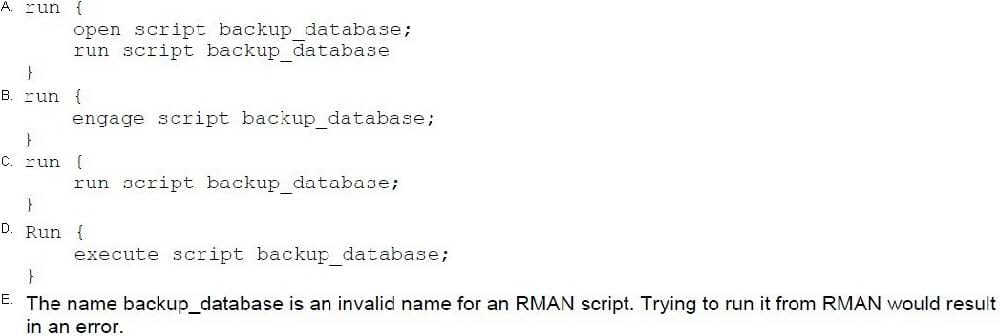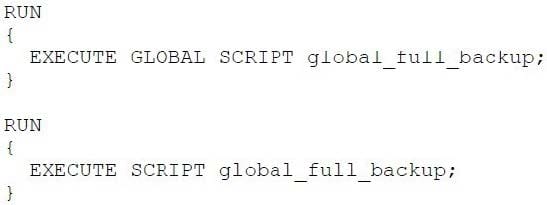Exam Details
Exam Code
:1Z0-053Exam Name
:Oracle Database 11g: Administration IICertification
:Oracle CertificationsVendor
:OracleTotal Questions
:736 Q&AsLast Updated
:Mar 26, 2025
Oracle Oracle Certifications 1Z0-053 Questions & Answers
-
Question 61:
While performing a regular check on your recovery catalog you realized that the catalog database is running out of space and you do not have options to increase the space. However, you have another database where more space is available and you want to move your existing recovery catalog to this database.
The options that can be considered while moving the recovery catalog are as follows:
1.
Using one of the Oracle expdp utilities to export the catalog data
2.
Creating a recovery catalog user and granting the necessary privileges in the other database
3.
Creating the recovery catalog using the CREATE CATALOG command
4.
Using the corresponding impdp utility to import the catalog data into the other database
5.
Registering the target database in the new catalog database using the REGISTER DATABASE command. Identify the option with the correct sequence for moving the recovery catalog.
A. 2, 3, 5
B. 1, 2, 4
C. 1, 2, 4, 5
D. 1, 2, 3, 4, 5
-
Question 62:
You are using the control file to maintain information about the database backups that are being performed by Recovery Manager (RMAN). Identify two scenarios is which you must have a recovery catalog. (Choose two.)
A. To store the backup information of multiple database
B. To restrict the amount of space that is used by the backups
C. To maintain a backup for a certain time is set by the CONTROL_FILE_RECORD_KEEP_TIME parameter.
D. To list the data files that were in a target database at a given time by using the AT option of REPORT SCHEMA command.
-
Question 63:
Which option is best practice for creating a recovery catalog owner in the catalog database?
A. Granting UNLIMITED QUOTA on the SYSTEM tablespace to the owner
B. Allocating the SYSTEM tablespace as the default tablespace and granting the SYSDBA privilege to the user
C. Creating a new tablespace, allocating this as the default, and granting UNLIMITED QUOTA on this tablespace to the user
D. Allocating the SYSAUX tablespace as the default tablespace and granting UNLIMITED QUOTA on this tablespace to the user
-
Question 64:
You have created a script in the recovery catalog called backup_database. Which of the following commands would successfully execute that script?

A. B. C. D. E.
-
Question 65:
In what order would you execute the following steps to create a recovery catalog?
a.
Issue the create catalog command.
b.
Create the recovery-catalog database.
c.
Create the recovery-catalog user.
d.
Grant the recovery_catalog_owner privilege to the recovery-catalog user.
e.
Issue the register database command from the target database.
A.
a, b, c, d, e
B.
b, a, d, c, e
C.
b, c, d, a, e
D.
b, c, d, e, a
E.
b, d, c, a, e
-
Question 66:
How would you grant the RVPC user access to specific RMAN database records in the RMAN virtual private catalog?
A. Issue the grant command from the SYS user (or equivalent) of the target database.
B. Issue the grant command from the SYS user (or equivalent) of the recovery-catalog database.
C. Issue the grant command from the recovery catalog-owning schema user account in the recovery catalog.
D. Issue the grant command from RMAN when connected to the recovery catalog-owning schema.
E. Issue the grant command from RMAN when connected to the target database.
-
Question 67:
The following databases are registered in the base recovery catalog: PROD1, PROD2, and PROD3.The database user CATOWNER owns the base recovery catalog. You want a new user VPC1 to have access to only the PROD1 database and create a virtual private catalog. The RVPC user can do which of the following? (Choose all that apply.)
A. Register databases if granted the register database privilege
B. See all databases in the recovery-catalog schema
C. See all database-related metadata in the recovery catalog if they are granted access to that database
D. Unregister databases from the RVPC catalog that were not granted to the RVPC catalog owner with the grant command
E. Not be connected to with the RMAN command-line catalog parameter for backup or recovery purposes
-
Question 68:
Given the script
create script db_backup_datafile_script
{backup datafile and 1, and2 plus archivelog delete input;}
What is the result of running this command?
Run {execute script db_backup_datafile_script using 2;}
A. The script will fail since you instructed RMAN to back up only one datafile rather than two.
B. The script will successfully back up datafile 3 without error.
C. The script will fail since it uses a substitution variable which is not supported.
D. The execute script command will prompt for the value of and2 since it's not included in the command.
E. The script will fail because you cannot use the plus archivelog command when backing up database datafiles.
-
Question 69:
Which is the correct way to connect to both the target database and the recovery catalog from the RMAN command line? Assume that the target database is called ORCL and that the recovery catalog database is called RCAT. Also assume that the recovery-catalog owner is called RCAT_OWN. Assume the environment is configured for the ORCL database. (Choose all that apply.)
A. rman target=/ catalog=/@rcat
B. rman target=/ catalog=rcat_own/rcat_own
C. rman target=/ catalog=rcat_own/rcat_own@RCAT
D. rman target=sys/robert@orcl catalog=rcat_own/rcat_own@RCAT
E. You cannot connect to the target database and the recovery catalog at the same time.
-
Question 70:
You have backed up your database twice without connecting to the recovery catalog.
What command do you issue to transfer the control-file metadata to the recovery catalog?
A. synch catalog
B. resync catalog
C. replicate catalog
D. update catalog
E. restore catalog
Related Exams:
1Z0-020
Oracle8i: New Features for Administrators1Z0-023
Architecture and Administration1Z0-024
Performance Tuning1Z0-025
Backup and Recovery1Z0-026
Network Administration1Z0-034
Upgrade Oracle9i/10g OCA to Oracle Database OCP1Z0-036
Managing Oracle9i on Linux1Z0-041
Oracle Database 10g: DBA Assessment1Z0-052
Oracle Database 11g: Administration Workshop I1Z0-053
Oracle Database 11g: Administration II
Tips on How to Prepare for the Exams
Nowadays, the certification exams become more and more important and required by more and more enterprises when applying for a job. But how to prepare for the exam effectively? How to prepare for the exam in a short time with less efforts? How to get a ideal result and how to find the most reliable resources? Here on Vcedump.com, you will find all the answers. Vcedump.com provide not only Oracle exam questions, answers and explanations but also complete assistance on your exam preparation and certification application. If you are confused on your 1Z0-053 exam preparations and Oracle certification application, do not hesitate to visit our Vcedump.com to find your solutions here.
